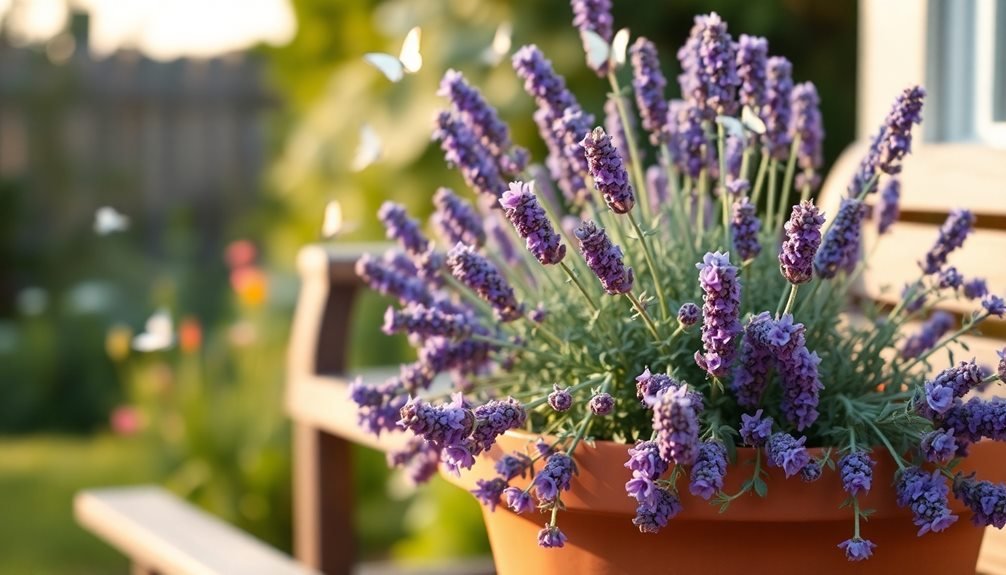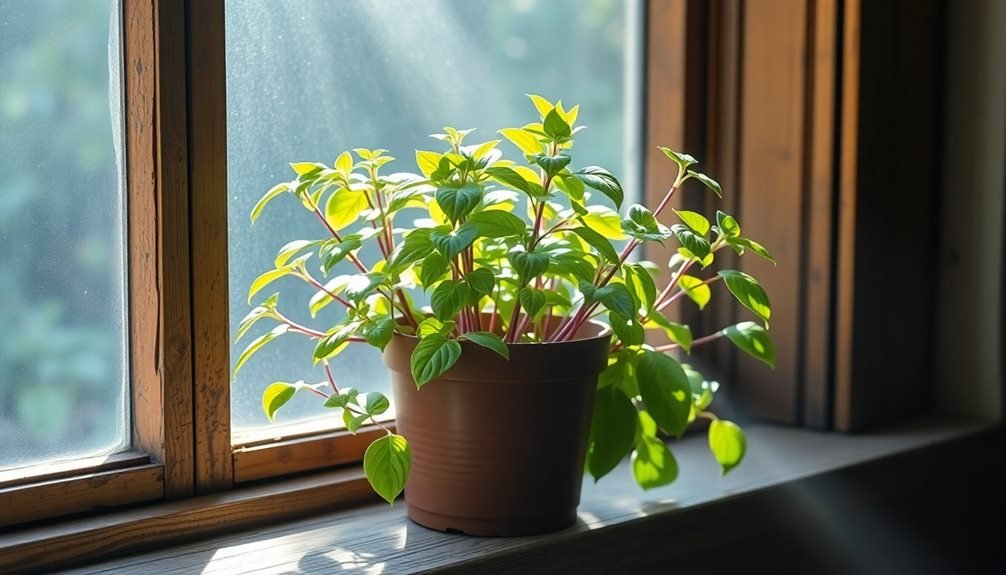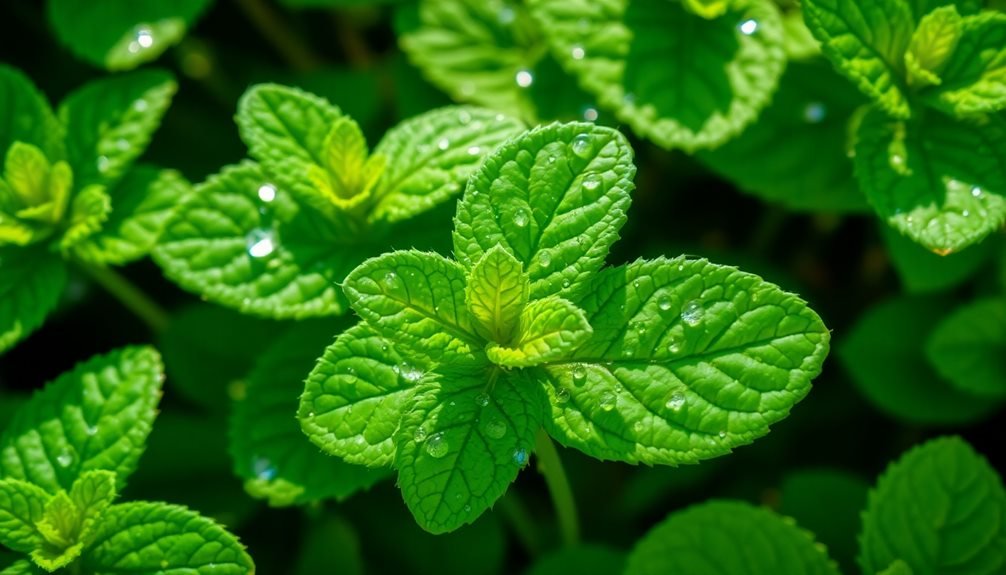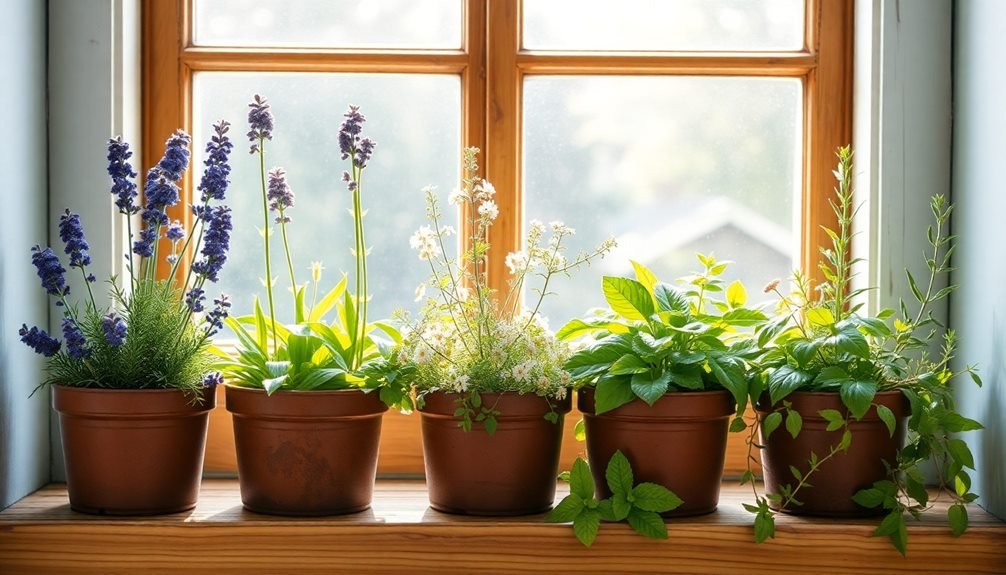Growing these five soothing herbs at home puts nature's stress remedies right at your fingertips. You'll have fresh lavender, chamomile, holy basil, lemon balm, and peppermint ready whenever you need to calm your mind or ease anxiety. These versatile plants don't just offer therapeutic benefits – they'll beautify your garden with vibrant colors and enchanting fragrances while attracting beneficial pollinators. You can harvest the leaves and flowers for teas, sachets, bath additions, and aromatherapy treatments throughout the growing season. Best of all, these hardy herbs are easy to maintain and can thrive in containers or garden beds. Let's explore how each herb can transform your wellness routine.
Lavender for Peace and Relaxation

Growing lavender brings a touch of Provence to your garden while providing one of nature's most effective calming herbs. This Mediterranean plant thrives in well-drained soil and full sun, making it perfect for container gardens or sunny borders.
You'll find that lavender's silvery-green foliage and purple spikes add both visual appeal and therapeutic benefits to your outdoor space.
You can harvest lavender's fragrant stems throughout the growing season, using them fresh or dried for multiple purposes. Place dried lavender buds in sachets under your pillow to promote restful sleep, or add them to your bath for a spa-like experience.
The essential oils in lavender help reduce anxiety and stress, while its gentle scent can ease headaches and promote relaxation.
To maintain your lavender plants, prune them back by one-third in early spring. This encourages bushier growth and prevents the plants from becoming woody at the base.
You'll get the best results by choosing varieties suited to your climate – English lavender (Lavandula angustifolia) proves hardiest in cold regions, while French lavender (Lavandula dentata) excels in warmer areas.
Chamomile's Gentle Touch
Known for its delicate, daisy-like flowers, chamomile brings soothing comfort to both your garden and your teacup. You'll find two main varieties to choose from: German chamomile, which grows tall with feathery leaves, and Roman chamomile, which forms a low-growing, aromatic ground cover. Both types thrive in well-draining soil and full sun, making them perfect additions to your herb garden.
Growing chamomile isn't just about harvesting its flowers for tea – it's also about creating a resilient garden ecosystem. The plant naturally repels many garden pests while attracting beneficial pollinators.
You'll want to harvest the flowers when they're fully open, typically in the morning after the dew has dried. Simply pinch off the flower heads and dry them on a screen in a well-ventilated area.
The herb's versatility extends beyond its calming tea properties. You can use fresh chamomile flowers in potpourri, natural skincare preparations, or as a gentle hair rinse.
If you're dealing with sleepless nights or anxiety, you'll appreciate having this natural remedy right outside your door. The plant's sweet, apple-like scent and gentle medicinal properties make it an essential addition to your therapeutic garden.
Holy Basil's Sacred Calm

While chamomile offers gentle comfort, holy basil brings a deeper sense of tranquility to your herb garden. Also known as Tulsi, this sacred Ayurvedic herb has been revered for thousands of years for its ability to reduce stress and anxiety while promoting mental clarity and emotional balance.
You'll find holy basil surprisingly easy to grow in your garden or on a sunny windowsill. Plant it in well-draining soil and provide at least six hours of direct sunlight daily. The plant grows up to two feet tall and produces beautiful purple-tinged leaves with a distinctive clove-like aroma.
To harness holy basil's calming properties, you can steep fresh or dried leaves in hot water for a soothing tea. The herb contains adaptogenic compounds that help your body manage stress and maintain healthy cortisol levels.
You'll also benefit from its natural anti-inflammatory and immune-boosting properties. For the freshest supply, harvest leaves regularly throughout the growing season, but don't take more than one-third of the plant at once.
You can dry excess leaves for year-round use by hanging bundles upside down in a well-ventilated area away from direct sunlight.
Lemon Balm's Natural Serenity
Countless gardeners cherish lemon balm for its bright citrusy fragrance and remarkable ability to ease anxiety and promote restful sleep. This gentle herb's calming properties make it a valuable addition to your garden, especially if you're seeking natural ways to unwind after stressful days.
You'll find lemon balm incredibly easy to grow, as it thrives in both full sun and partial shade. Plant it in well-draining soil, and you'll soon have an abundant supply of fresh leaves for teas, tinctures, and aromatherapy.
Just remember to contain it in pots or designated areas, as it can spread quickly through self-seeding.
To harness lemon balm's soothing benefits, you can steep fresh or dried leaves in hot water for a calming tea, particularly effective before bedtime. The herb's active compounds help reduce cortisol levels and promote GABA production in your brain, naturally easing tension and anxiety.
You can also add the leaves to bath sachets or combine them with other herbs like lavender for enhanced relaxation effects.
For the freshest results, harvest leaves in the morning when their essential oils are most concentrated, and use them immediately or dry them for future use.
Peppermint's Fresh Mindfulness

Growing peppermint in your home garden offers both mental clarity and stress-relief benefits. You'll find this hardy perennial surprisingly easy to maintain, as it thrives in partial shade and adapts well to container growing.
Just remember to plant it in confined spaces, as peppermint spreads aggressively through underground runners.
The natural menthol in peppermint leaves stimulates your senses and promotes alertness while simultaneously calming anxiety. You can harvest the leaves throughout the growing season, using them fresh or dried for therapeutic teas.
Simply steep 1-2 teaspoons of crushed leaves in hot water for 5-7 minutes to create a rejuvenating brew that helps improve focus and digestion.
Beyond tea, you'll discover numerous ways to incorporate peppermint into your wellness routine. Crush fresh leaves between your fingers when you need a quick mental boost, or add them to your bath water for a naturally invigorating soak.
You can also create a calming room spray by steeping leaves in witch hazel for two weeks. The plant's strong scent naturally repels pests too, making it a practical addition to your garden's defensive lineup.
Frequently Asked Questions
Can These Herbs Be Grown Together in the Same Container Garden?
You can grow most herbs together in containers if they share similar growing needs for sunlight, water, and soil. Just guarantee there's enough space between plants and proper drainage for healthy growth.
What's the Minimum Temperature These Calming Herbs Can Tolerate?
You'll need to keep most calming herbs above 50°F (10°C) to thrive. While they can survive brief cold snaps, it's best to bring them indoors when temperatures drop below 45°F (7°C).
How Long Do These Herbs Typically Take to Harvest?
You'll be able to harvest most calming herbs within 6-8 weeks after planting. However, you can start trimming leaves for use when plants reach 6-8 inches tall, as long as they're healthy.
Are These Herbs Safe to Grow Around Pets?
You'll need to check each herb's safety for your pets. Some common herbs like lavender and chamomile are safe, but others can be toxic. It's best to research specific herbs and keep them out of reach.
Can These Soothing Herbs Be Used Fresh or Must They Be Dried?
You can use most soothing herbs both fresh and dried in your remedies. While fresh herbs offer vibrant flavors, dried herbs are more concentrated and last longer. It's great to have both options available.
In Summary
Growing these five calming herbs at home lets you create your own natural sanctuary of peace. You'll have fresh ingredients for teas, aromatherapy, and natural remedies right at your fingertips. Whether you're sipping chamomile tea, inhaling lavender's sweet scent, or brewing holy basil, you're nurturing both your garden and your well-being. Start planting these soothing herbs today, and you'll reap the benefits of nature's tranquility.





Leave a Reply